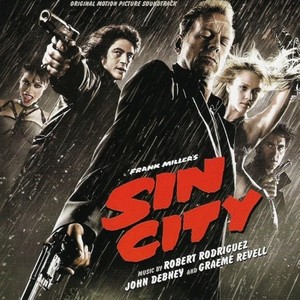
- 歌曲
- 时长
简介
影片由Frank Miller的小说改编而成。影片讲述三个故事:Sin City,The Big Fat Kill和That Yellow Bastard。这三个故事都发生在一个虚构的城市:罪恶之城。在这座被暴力所摧残的城市中,警察已经被黑帮所腐化。影片将有三条故事主线,最主要的Sin City讲的是Mickey扮演的暴力警察Marv,因为一个与他有过一夜情的漂亮女人死于因他而起的复仇,他准备在这个城市里大开杀戒…… 除主角布鲁斯·威利斯之外,影片还集中了克利夫·欧文、伊利亚·伍德、布兰妮·墨菲等多位明星,可谓群星辉映。然而,本片最大的功臣当属导演罗伯特·罗德里格斯。弗兰克·米勒对好莱坞有成见,早在十几年前就宣布拒绝与电影人合作。罗德里格斯硬是自己筹资,将《罪恶之城》中的一个故事拍成短片,并亲自送到弗兰克·米勒的手中,最终打动了对方。 在漫画里,弗兰克·米勒给每个人深浅不同的墨色;在电影里,罗伯特·罗德里格斯认为每个人都是一幅画。所以,他给演员不同的用光,不光把演员从背景中抽离,还把每个演员跟其他人处理得不一样。罗伯特·罗德里格斯就是这样严谨地紧扣原著。正如米勒所说,“我们是在一起完成我的画,所以,我们必须不断调整,直到完全符合我的创作为止。” Robert Rodriguez and Frank Miller's eye-popping adaptation of Miller's noir comic Sin City boasts an equally gritty, stylized score to match its visual flair. As with all of Rodriguez's films, he was actively involved in Sin City's music, writing a fair chunk of the score himself and turning to two of his frequent collaborators, Graeme Revell (who worked with Rodriguez on the From Dusk 'Til Dawn soundtrack) and John Debney (who contributed to the Spy Kids 1 and 2 scores), to work on the rest, with and without him. Rodriguez scored most of Sin City's Hartigan (Bruce Willis) storyline, aka "That Yellow Bastard" to fans of the comic, and his "Sin City" theme sets the tone for the rest of the score: it's down and dirty, like the "Peter Gunn" theme gone to hell, with a beautifully ugly sax sound that adds a glamorously nasty edge to the piece (and everywhere else it pops up). Revell scored the Marv storyline, which comes from the first Sin City comic, and Debney's score revolves around the Dwight/Miho story originally known as "The Big Fat Kill." All three parts of the score blend jazz, spy, and especially film noir soundtrack elements with subtle rock and electronic touches; though they work well as a whole, there's something to be said for each of the composers' individual approaches as well. Revell's tracks are the most percussive and electronic; there's an almost industrial bent to the drums on "Marv" and "Bury the Hatchet." "Her Name Is Goldie" and "Goldie's Dead," meanwhile, concentrate on the haunting flute and vocal motifs that collide with Revell's edgier sounds on "The Hard Goodbye." Despite Sin City's stylishness, it's still fairly restrained; Rodriguez, Revell, and Debney know when to pull back from going too over the top. This is especially true of Debney's pieces, which are the closest to traditional noir film music in the score. Along with reflecting the bleak, harsh aspects of the story, tracks like "Dwight" and "Warrior Woman" also capture Sin City's very real undercurrents of sorrow: the string parts move from eerie to bittersweet, and the horns go from dangerously taut to brooding, particularly on "The Big Fat Kill," which is sad, angry, and violent all at once. Rodriguez's pieces are some of the showiest and most evocative, ranging from "Prison Cell," which sounds like sinking into darkness, to the theatrical evil of "That Yellow Bastard." "Sin City End Titles" is a bigger and badder reprise of the film's theme with a more rock-based arrangement and more than a little bit of a wink in its delivery. The soundtrack also includes two non-score tracks. Fluke's "Absurd" has a more "modern," big beat/rock sound than the rest of the album, but it feels oddly dated and out of place compared to the more timeless-sounding music that surrounds it. However, "Sensemaya," a 1976 piece from Mexican composer Silvestre Revueltas, is right in keeping with the score's elegant menace; it's easy to hear why Rodriguez says in the album's liner notes that this piece was a big influence on him. A wonderful update of film noir music traditions, the soundtrack remains faithful to that basic sound, but not too faithful to inject some fresh ideas into it. Along with The Incredibles, Sin City is one of the most stylish and entertaining -- not to mention effective -- scores in recent memory.







